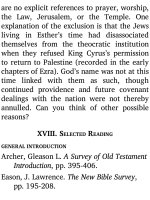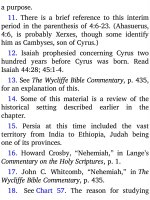Jensens survey of the old testament adam 268
Bạn đang xem bản rút gọn của tài liệu. Xem và tải ngay bản đầy đủ của tài liệu tại đây (144.33 KB, 4 trang )
3:7-13).
535-534 B.C. Opposition to the Temple
project by the neighboring Samaritans
(Ezra 4:1-5).
534 B.C. Work on the Temple ceases5 (Ezra
4:24).6
536-520 B.C: Israel’s ruler is governor
Zerubbabel, who represents the king of
Persia. Joshua the high priest is their
religious leader.
520 B.C. Haggai and Zechariah “prophesied
to the Jews who were in Judah and
Jerusalem, in the name of the God of
Israel” (Ezra 5:1; cf. Hag 1:1). Temple
project is resumed (Ezra 5:2; Hag 1:1415). For how many years had the people
neglected the work?
516 B.C. Temple project is finished (Ezra
6:14-15).
Chart 114 shows the ever changing
spiritual state of Israel during Old Testament
times, and how Haggai’s and Zechariah’s
ministries related to this.
3. The importance of the Temple. We may
rightly ask why the Temple building was so
crucial in the life of the Jews who had
returned to Jerusalem. Gleason Archer
suggests two basic reasons.
It should be remembered that much of
the Mosaic constitution presupposed
the carrying on of worship in such a
sanctuary, and the failure to complete
a suitable house of worship could lead
to a paralyzing of the religious life of
the Jewish community. It should also
be understood that the second temple
was to play a very important role in
the history of redemption, for it was in
this temple (as remodeled and
beauti ed by Herod the Great) that the
Lord Jesus Christ was to carry on His
Jerusalem ministry. It was, of course,
His advent that ful lled the promise of
Haggai 2:9, “The glory of this latter
house shall be greater than of the
former.”7
The Temple building itself, as a symbol,
was intended to remind the Israelites that
God was a real Person, alive, dwelling in
Zion (Joel 3:21), and wanting to enjoy
fellowship with man as well as be worshiped
by him. Exodus 25:8, referring to the
original tabernacle, gives clear insight into
this fellowship aspect: “And let them
construct a sanctuary [miqdash, “a place set
apart”] for Me, that I may dwell among
them.” There was no higher spiritual
experience for a Jew in Haggai’s time than
by faith to let God as Lord dwell personally
in his heart. (Cf. Acts 7:47-48; Isa 66:1-2.) In
such an experience the Temple symbol bore
its choicest and eternal fruit.
4. Theme of the book. The divine message
which Haggai passed on to his Jewish
brethren could be summarized thus: “If you
want to be restored to a blessed relationship
with the Lord, put rst things rst in your









